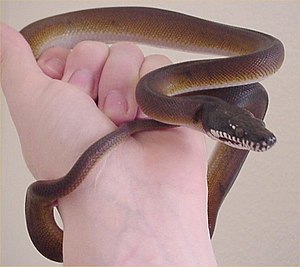White-lipped python
| White-lipped python | ||||||||||||
|---|---|---|---|---|---|---|---|---|---|---|---|---|

White-lipped python ( Bothrochilus albertisii ) |
||||||||||||
| Systematics | ||||||||||||
|
||||||||||||
| Scientific name | ||||||||||||
| Bothrochilus albertisii | ||||||||||||
| ( Peters & Doria , 1878) |
The white-lipped python ( Bothrochilus albertisii , syn .: Leiopython albertisii ), also called the northern white-lipped python , is a species of the genus Bothrochilus from the python family . No subspecies are currently recognized. The species was named in honor of Luigi Maria d'Alberti . While the white-lipped python used to be the only species of the genus Leiopython that was monotypical , according to studies by Hoser 2000 and Schleip and O'Shea 2010, five other species are placed in the genus Leiopython . In 2014 , Reynolds and colleagues synonymized the leiopython with Bothrochilus .
description
The white-lipped python reaches up to three meters in length and has a medium to dark brown body color without pattern, throat and belly are light gray or yellowish. The head is long and clearly set off from the slender body, black-brown to black in color and has conspicuous white shields of the upper and lower lips with black front edges. The northern white-lipped python often has a whitish spot behind the eye. The whole body is highly iridescent , that is, when viewed from a certain angle, the skin shimmers like a rainbow.
Behind the two internasal shields lie two elongated prefrontal shields and a large frontal shield , to which a pair of parietal shields are attached. These paired parietal shields differentiate the northern white-lipped python from the southern white-lipped python ( Bothrochilus meridionalis (Schleip, 2014), syn .: Bothrochilus hoserae ) and the other species Bothrochilus montanus (Schleip, 2014) syn .: Bothrochilus bennettorum and Bothrochilus huonensis . The eye is surrounded by a pre-ocular , a large supra-ocular and three to four post- ocular shields and is adjacent to the fifth to seventh of the 12 to 14 supralabial shields . The infralabial shields number 14 to 18. The middle of the trunk has 44 to 55 rows of smooth scales, the belly 259 to 283 ventral and 62 to 72 paired subcaudal shields and an undivided anal shield .
distribution
The white-lipped python is found in New Guinea (below 1200 meters), including the islands of Salawati and Biak , on Normanby , Mussau and on a number of islands in the Torres Strait . The species lives mainly on the ground in rainforests and marshland , usually near water, which is used as a refuge when disturbed.
Way of life
The white-lipped python feeds primarily on small to medium-sized mammals, birds and reptiles.
The females lay about a dozen eggs in a compact pile. As with other Phyton species, the clutches are guarded by the mother. After about 57-79 days, the young hatch, which at this time have a length of about 35-40 centimeters.
Web links
- Leiopython.de with pictures and detailed description
- Bothrochilus albertisii in The Reptile Database ; accessed on September 4, 2018.
swell
- Ludwig Trutnau : Non-poisonous snakes, part 1 . 4th edition. Eugen Ulmer GmbH & Co., Stuttgart 2002, ISBN 3-8001-3223-0 .
Individual evidence
- ↑ a b c Bothrochilus albertisii in The Reptile Database
- ↑ Peters W and G Doria. 1878. Catalogo dei retilli e dei batraci raccolti da O. Beccari , LM D'Alberts e AA Bruijn. nella sotto region Austro-Malese. Annali del Museo Civico de Storia Naturale di Genova. ser. 1 (13): 401-403, plate III, Fig. 2.
- ^ R. Graham Reynolds, Matthew L. Niemiller, Liam J. Revell: Toward a Tree-of-Life for the boas and pythons: Multilocus species-level phylogeny with unprecedented taxon sampling. Molecular Phylogenetics and Evolution, Volume 71, February 2014, Pages 201-213, doi: 10.1016 / j.ympev.2013.11.011 .
- ↑ Mehrtens JM. 1987. Living Snakes of the World in Color. New York: Sterling Publishers. 480 pp. ISBN 0-8069-6460-X .
- ↑ McDiarmid RW, Campbell JA, Touré T. 1999. Snake Species of the World: A Taxonomic and Geographic Reference. Volume 1. Herpetologists' League. 511 pp, ISBN 1-893777-00-6 (series). ISBN 1-893777-01-4 (volume).